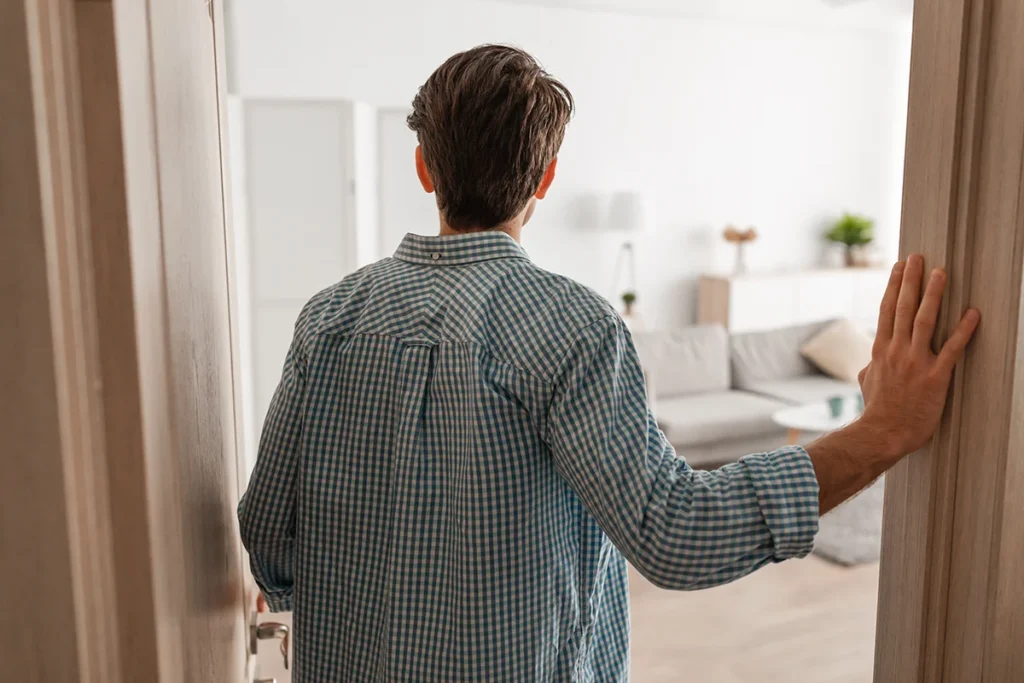- The Foundation: It All Starts at Move-In
- Utah Law & The Security Deposit
- Conducting the Final Walk-Through
- The Rhino Property Management Advantage
A smooth, professional, and compliant move-out process is not just about getting the keys back; it’s about legally protecting your property, ensuring a quick return to the market, and, most critically, safeguarding your right to the security deposit. Navigating this period according to state statutes is crucial for any Salt Lake City landlord guide to success.
The Salt Lake City rental market is famously competitive and fast-paced. A successful property investment in this dynamic environment often hinges on efficient tenant turnover. When a lease ends, time is money—every day a unit remains vacant is lost rental income.
A well-documented move-out process, based on the foundation of a thorough move-in inspection and a clear understanding of Utah law, is the best way to protect your property and avoid costly security deposit disputes.
The Foundation: It All Starts at Move-In
A fair and legally defensible move-out is virtually impossible without a detailed and indisputable record of the property’s initial condition. The move-out is merely a comparison of the “before” and “after.”
The Critical Move-In Inspection: Your Baseline
Before the tenant receives the keys, you must establish the move-in inspection record. This detailed report serves as your binding contract on the condition of the unit.
- Signed Move-In Condition Checklist: Use a form that explicitly details the condition of every surface, appliance, and fixture. Both you (or your agent) and the tenant should sign this checklist, acknowledging and agreeing to the state of the property. This eliminates the “he said, she said” scenario before it ever starts.
- List Existing Imperfections: Note every scratch, ding, or stain. If the carpet is already worn in the dining area, detail it. If the blinds have a slight bend, document it. This prevents a tenant from claiming pre-existing damage was caused during their tenancy.

Photo & Video Evidence: Date-Stamped Documentation
Paper checklists are only one part of the equation; visual proof is the gold standard in a dispute.
- Extensive Coverage: Take high-resolution, date-stamped photos and videos of every room, closet, appliance, and fixture. Focus on high-damage areas like carpet edges, bathtub caulk, door jambs, and wall corners.
- Capture the Details: Zoom in on any minor pre-existing damage noted on the checklist. For instance, if a stovetop burner has a stain, get a close-up photo.
- Secure Storage: Store this evidence digitally and safely. This documentation is your “before” picture—the evidence you’ll rely on when conducting the final walk-through.
Utah Law & The Security Deposit
For any Salt Lake City landlord guide, an understanding of state statutes is paramount. The handling of the security deposit is the most legally sensitive part of the move-out process, governed by Utah security deposit law.
The 30-Day Rule: Compliance Under Utah Code § 57-17-3
This is the most critical deadline a landlord must follow. Under Utah Code § 57-17-3, a landlord has a finite and legally mandated timeframe to handle the security deposit.
- The Deadline: The owner has 30 days from the tenant’s move-out date and return of possession to either return the full security deposit or provide a written, itemized list of deductions and the remaining balance.
- The Penalty for Non-Compliance: Failure to meet this 30-day deadline can result in the landlord forfeiting the right to retain any portion of the deposit, even if there are legitimate damages. Furthermore, the tenant may be entitled to the full deposit, any prepaid rent, and a penalty of $\$100$, plus court costs and attorney fees if litigation is required.
Delivering the Notice: The Forwarding Address Problem
The written, itemized list of damages for the security deposit in Utah must be formally delivered to the tenant.
- Legal Delivery: This notice must be delivered or mailed to the tenant’s last known address or electronically by a provided means.
- The Importance of a Forwarding Address: If the tenant fails to provide a forwarding address, the landlord must send the itemized list to the rental unit’s address, as that is the last known address. However, requiring a forwarding address in your lease agreement is standard best practice to ensure the tenant receives the statement and the remaining funds. Landlords may have a 15-day extension if the forwarding address is received after the 30-day deadline, but relying on the 30-day window is the safest approach.

Normal Wear and Tear vs. Damages in Utah: Drawing the Legal Line
Utah landlord-tenant law allows deductions for property damage that goes “beyond reasonable wear and tear.” Distinguishing between normal wear and tear vs damage Utah is essential for a legally sound deduction. The age of the item (e.g., a 15-year-old carpet is near the end of its useful life) is often a factor in calculating the deduction amount.
Wear and Tear (Not Deductible)
Normal wear and tear is the inevitable deterioration that results from the tenant’s ordinary, careful use of the property. Landlords cannot deduct from the deposit for these items:
- Worn Carpet in Walkways: Thinning or minor fraying of carpet fibers in high-traffic areas (e.g., in front of the sink or leading to the bedroom).
- Minor Scuffs on Paint: Light, superficial marks or scratches on walls from furniture placement or general movement.
- Faded Paint or Blinds: Discoloration caused by sunlight or aging, not tenant action.
- Loose Doorknobs or Hinges: Hardware loosening from repeated, everyday use.
Damages (Deductible)
Damages result from a tenant’s abuse, misuse, carelessness, or negligence. Landlords can deduct from the deposit for the cost of repairing these items:
- Large Holes in the Wall: Holes from a poorly installed TV mount, a punch, or an impact that requires drywall repair beyond simple spackling.
- Broken Appliances Due to Negligence: A garbage disposal ruined by foreign objects or a dishwasher door broken by excessive force.
- Damage from Sports Equipment: Significant scrapes, gouges, or holes on walls or floors caused by the negligent storage or handling of skis, snowboards, or bikes inside the unit.
- Significant Pet Stains/Odor: Stains in the carpet or pad from pet urine that require replacement or specialized remediation, which is explicitly considered damage beyond normal wear.

Conducting the Final Walk-Through
The final walk-through is the pivotal step where you transition from documenting a former tenancy to preparing for a new one. This systematic, objective inspection justifies your deductions and informs your turnover process.
Use the Landlord Move-Out Checklist Utah
After the tenant has completely vacated the property and returned all keys, the inspection must be performed. The key to this process is direct comparison.
- Item-by-Item Comparison: Do not rely on memory. Take the original move-in inspection checklist—the document signed by both parties—and go through the property, room by room, item by item.
- Note the Change in Condition: For every item (kitchen counter, hallway wall, refrigerator interior), note the final condition and whether the change is wear and tear or damage. A clean-out checklist will guide you to areas frequently neglected by tenants.
- Confirm Key Return: Verify that all keys, fobs, and garage door openers have been returned. Failure to return keys means the tenant has not fully surrendered possession, and you may be able to charge rent until the keys are received.
Document the “After” Picture: The Side-by-Side Defense
If a dispute over the deposit arises, a judge or mediator will rely heavily on documented evidence. Your “before and after” pictures are the most powerful evidence you can present.
- New Photos of Damages: Take new, high-quality, date-stamped photos of any damage found. These photos should directly correspond to the rooms and items documented during the initial move-in inspection.
- Visual Narrative: For example, place the “after” picture of the hole in the wall directly next to the “before” picture showing a perfectly clean wall. This visual narrative is impossible to refute and protects your claim to the deposit.
- Cleaning Standard: Take photos of any areas left excessively dirty. You can deduct cleaning costs only to bring the unit back to its original move-in condition, but often a tenant leaves a unit far below that standard.

Calculate Repair Costs: Fair and Itemized Deductions
Deductions must be for the actual cost of repairs, replacement, or cleaning. You cannot simply pull a number out of the air.
- Keep Receipts and Bids: Deductions must be substantiated with genuine documentation. Keep receipts from contractors for repairs or replacement costs, or for materials purchased. If a repair is performed in-house, you must document the reasonable hourly rate, time spent, and materials used.
- Depreciation (The Useful Life Rule): Remember that a landlord cannot charge a tenant the full replacement cost for an item that has exceeded or is near the end of its useful life. For example, if a carpet’s expected lifespan is 10 years, and it’s 8 years old when the damage occurs, you can only charge for $2/10^{\text{th}}$ of the replacement cost, reflecting the remaining useful life.
- Generate the Itemized Deductions List: Create a clear, comprehensive statement. This is the itemized list of damages for the security deposit Utah that must be delivered to the tenant. It should detail:
- The original security deposit amount.
- Each specific deduction (e.g., “Repair large hole in bedroom drywall,” “Replace damaged kitchen tile,” “Professional cleaning of oven”).
- The corresponding cost for each deduction.
- The calculation of the remaining balance to be returned.
Returning security deposit in Utah 30 days after move-out requires this detailed list to be included with the remaining deposit balance.
The Rhino Property Management Advantage
For the successful Salt Lake City landlord guide, the difference between compliance and costly litigation often comes down to professional management. The complexity of Utah code § 57-17-3 and the nuances of Utah landlord-tenant law make professional assistance invaluable.
An Ironclad System: Consistency is Key
We remove the risk and stress for the owner by implementing a consistent, documented process for every single tenancy.
- Document Management: We handle every step of the move-out process, from the initial, high-definition photo documentation at move-in to the final, detailed itemized deductions statement at move-out. Our system ensures every document is signed, dated, and stored securely.
- Proactive Planning: We coordinate maintenance, cleaning, and necessary repairs immediately upon move-out. This allows us to rapidly secure contractors, calculate the actual cost of repairs, and minimize the unit’s downtime, optimizing your tenant turnover cycle.

Expertise in Utah Code: Avoiding Legal Pitfalls
As property management experts in the Salt Lake City area, we are not just managing properties—we are managing legal risk.
- Compliance Guarantee: We are experts in statutes like Utah Code § 57-17-3 and the intricacies of Utah security deposit law. We guarantee that the itemized statement and the remaining funds are mailed or delivered to the tenant’s forwarding address within the 30-day window, ensuring you remain compliant and avoid legal trouble, which often forces a landlord to refund the entire deposit.
- Up-to-Date Knowledge: Utah landlord-tenant law can change. We stay current on all local and state legal interpretations, particularly regarding what constitutes normal wear and tear vs damage in Utah, ensuring your deductions are always legally sound.
Objective Third-Party: Removing Emotion from Disputes
Disputes over deposits are inherently emotional for both the departing tenant and the owner.
- Professional Buffer: Rhino Property Management acts as a professional, objective buffer. We remove the owner from direct, often confrontational, negotiation with the tenant.
- Fact-Based Resolution: Our decisions are based entirely on documented facts: the signed move-in checklist, the date-stamped photo evidence, and contractor receipts. This reliance on evidence-based documentation ensures a fair outcome for all parties and significantly reduces the likelihood of costly court action.
Successfully navigating the move-out process in the Salt Lake City rental market requires more than just collecting the keys. It demands a professional, systematic, and legally compliant approach.
By setting the foundation with a thorough move-in inspection, adhering strictly to the 30-day rule under Utah Code § 57-17-3, meticulously documenting the final walk-through, and clearly providing an itemized list of damages for the security deposit in Utah, you turn a potentially stressful event into a routine, profitable business process. Following this professional system protects the owner legally and financially against costly disputes and ensures the property is quickly prepared for its next high-quality tenant.
Stop worrying about deadlines, legal statutes, and security deposit disputes. Let us handle the details. Contact Rhino Property Management today to learn how our proven move-out process and expertise in Utah landlord-tenant law can protect your Salt Lake City investment and maximize your returns.

